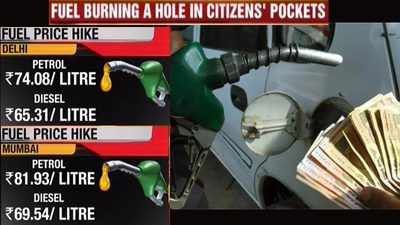- News
- Business News
- India Business News
- No relief as crude prices to rise by 20% in 2018: World Bank
Trending
This story is from April 26, 2018
No relief as crude prices to rise by 20% in 2018: World Bank
The World Bank has projected a 20% jump in global prices of energy commodities — crude oil, gas and coal — this year, indicating a continued squeeze on fuel consumers in India and raising the prospect of cramping the government’s social spending ability as it heads back to the people for another mandate.

Representative image
Key Highlights
- The World Bank has projected a 20% jump in global prices of energy commodities this year
- This indicates a continued squeeze on fuel consumers in India and raises the prospect of cramping the government’s social spending ability
- According to the Bank’s April commodity markets outlook, oil prices will average $65 a barrel through 2018
NEW DELHI: The World Bank has projected a 20% jump in global prices of energy commodities — crude oil, gas and coal — this year, indicating a continued squeeze on fuel consumers in India and raising the prospect of cramping the government’s social spending ability as it heads back to the people for another mandate.
According to the Bank’s April commodity markets outlook, oil prices will average $65 a barrel through 2018, 22% higher than the average price of $53 in 2017, due to the combined effect of production cut by Opec and Russia — the largest exporter outside the grouping of 14 oil exporting countries — and an uptick in demand.
This is not good news for India, which imports 80% of its crude requirement. Already pump prices are at multi-year highs as Brent hovers near $74 a barrel. Brent holds a big sway over the overall cost of India’s crude purchase since it has 28% weightage in India’s oil basket.

The government expects the oil import bill to rise 20% from $88 billion in 2017-18 to $105 billion in the current fiscal, at an average crude price of $65 per barrel. This is 64% higher than $64 billion in 2015-16 when prices were practically in a free fall.
Falling oil prices reduced subsidy burden and helped improve macro-economic parameters such as CAD (current account deficit) and kept inflation in check, prompting RBI to lower interest rates in August 2017.
The government also used this window to mop up additional resources for welfare schemes by cumulatively raising excise duty by Rs 11.77 per litre on petrol and Rs 13.47 on diesel between November 2014 and January 2016.
In October 2017, the tax was cut by Rs 2 a litre as protests became louder over rising pump prices since August 2016 on the back of a rebound in crude. The situation looks familiar as demand for another tax cut grows louder. But that’s only a small problem.
The larger issue is that high oil prices can upset the government’s maths, more so if it is forced to cut excise. Though the government does not buy oil or gas, their high prices become a drag on the rupee as forex outgo increases.
The subsidy bill too goes up. These factors trigger higher inflation and limit the legroom for government spending needed to push growth.
According to the Bank’s April commodity markets outlook, oil prices will average $65 a barrel through 2018, 22% higher than the average price of $53 in 2017, due to the combined effect of production cut by Opec and Russia — the largest exporter outside the grouping of 14 oil exporting countries — and an uptick in demand.
This is not good news for India, which imports 80% of its crude requirement. Already pump prices are at multi-year highs as Brent hovers near $74 a barrel. Brent holds a big sway over the overall cost of India’s crude purchase since it has 28% weightage in India’s oil basket.

Though the global benchmark crude slipped 1% on Wednesday as apprehensions over US sanctions on Iran eased a bit after Tuesday’s talks between the US and French presidents, other factors contributing to high oil prices still remain at play.
The government expects the oil import bill to rise 20% from $88 billion in 2017-18 to $105 billion in the current fiscal, at an average crude price of $65 per barrel. This is 64% higher than $64 billion in 2015-16 when prices were practically in a free fall.
Falling oil prices reduced subsidy burden and helped improve macro-economic parameters such as CAD (current account deficit) and kept inflation in check, prompting RBI to lower interest rates in August 2017.
The government also used this window to mop up additional resources for welfare schemes by cumulatively raising excise duty by Rs 11.77 per litre on petrol and Rs 13.47 on diesel between November 2014 and January 2016.
In October 2017, the tax was cut by Rs 2 a litre as protests became louder over rising pump prices since August 2016 on the back of a rebound in crude. The situation looks familiar as demand for another tax cut grows louder. But that’s only a small problem.
The larger issue is that high oil prices can upset the government’s maths, more so if it is forced to cut excise. Though the government does not buy oil or gas, their high prices become a drag on the rupee as forex outgo increases.
The subsidy bill too goes up. These factors trigger higher inflation and limit the legroom for government spending needed to push growth.
End of Article
FOLLOW US ON SOCIAL MEDIA















